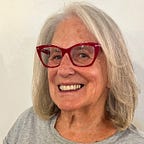How to Prevent Being Seen as “Old”
The Wall Street Journal had an article about aging that is worth reading, but was behind a pay wall. Because it cuts to the chase about everything I believe and needs to be more widely appreciated, I’m summarizing it here. It’s the data behind everything I try to tell people: what you do when you are younger determines what you will be able to do when you are older. And what you are able to do determines how you will be seen. Now, at age 75, I’m reaping the benefits of 25 years of running, twenty years of yoga, a lifetime of weights, bands and isometric exercises, Pilates, and all the other stuff I’ve done over the years.
For most people, the eyes are first thing they notice about aging. But the eyes don’t really change until 40, while hearing loss starts at age 25 (concerts, anyone?) and bone mass starts to decline in the 30s. Hearing is apparently best between 18 and 25, and it’s all downhill from there. Getting people to exercise in their 20s and 30s, when they are raising children and establishing careers is difficult, but I’m out to do my share. At age 30, I learned to play tennis and began a lifetime of exercise.
I’m also a big fan of good nutrition.
Like many people, I began to notice balance issues in my 50s, and that’s when lower body strength declines as well. Here’s the money quote:
“Every function of the human body declines 5% every 10 years,” says Michael Roizen,chairman of the Wellness Institute at the Cleveland Clinic. “That’s brain function, heart function, liver function. The difference is when you sense it and when it hits the critical level where it decreases functioning for you.”
Because I noticed the balance issues, I began to practice yoga. If I hadn’t done that, at the age I am now I would have much worse issues. Many people my age are in walkers and wheelchairs. And if you didn’t practice yoga, or regularly try balancing on one leg for a minute, you’d never know you had a balance issue until you started falling.
The mind, of course, starts to decline almost as soon as you get out of school. Cognitive processing and working memory can start to face in the 20s. Learning new things can be more difficult, which is why many older people are put off by technology. To prevent that, do one task at a time (who does?) and do it until you are finished.
Forty may be the new 30, but that doesn’t prevent presbyopia (the inability to read things close up) and dry eye becomes more common. More important, we need to know that the worst thing that can happen to your eyes is age-related macular degeneration. Fortunately, a good diet can prevent that: leafy green veggies, vitamin C and E.
Because bone mass loss starts at about 30, exercise is important. We also lose muscle mass at the rate of 10% per decade. It’s the bone loss and muscle mass that cause the problems with balance and walking. And if you are not fit in your forties, you are going to have real trouble when you get to 65.
I’ve seen it first hand. One reason we have ageism in our society is because the people who don’t stay fit are the image most of us know about aging. To present another image, which we all want to do, we have to work at it. Invest time earlier, and you will be happy later.
